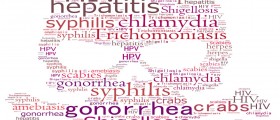
What are Sexually Transmitted Diseases?
Sexually transmitted diseases are infections transferred from one individual to another usually via sexual interaction. It is estimated that almost 20, 000, 000 cases of STDs are reported every year, while the population that they affect the most are teenagers and young adults. Some sexually transmitted diseases are bacterial infections, such as gonorrhea, and they are treated with antibiotics. Others are viral illnesses, such as AIDS and genital herpes, for which there is no cure. If left untreated, many STDs can cause serious health problems, such as cervical cancer or complications during pregnancy, while others, such as AIDS, cause death. The only sure way to protect yourself from contracting a sexually transmitted disease is not to engage in sexual activity. The most effective alternative is to always use a condom, and have only one sexual partner.
List of Common Sexually Transmitted Diseases
There are many common STDs, and one of these is gonorrhea. Gonorrhea is the most widespread, and if left untreated can lead to infertility. Chlamydia is also a very prevalent problem, and it can be particularly dangerous as it usually generates no symptoms. It is detected through regular check-ups at a doctor’s office. Herpes is another kind, and because it is a viral infection it is not curable, and it can keep coming back. Another virus with no cure is HIV, which causes AIDS, and ultimately leads to death. HPV, another virus, is very prevailing, more so among women than men, and if left untreated can cause cancer of reproductive organs.
In addition, there are sexually transmitted diseases that are less common, such as bacterial vaginosis. Bacterial vaginosis is manifested through painful urination and can ultimately lead to kidney disease. Molluscum contagiosum is a virus that produces tiny sores which are surgically removed at a doctor’s office. Mucopurulent cervicitis causes cervix to leak, and can result in serious difficulties during pregnancy. Nongonococcal urethritis is a men’s only sexually transmitted disease which causes difficulties with urination and may come as a result of chlamydia.
Tests for Common Sexually Transmitted Diseases
Sexually active individuals should have periodic tests done, especially after engaging in sexual activity with a new partner. Most sexually transmitted diseases are diagnosed after a blood test, but many can be visually detected as well. Tests that are performed to detect HPV, for instance, include a trip to the doctor’s office for a visual inspection, as this virus causes changes on the genitals usually visible to the naked eye. The doctor could also take a sample from the genitals to make further diagnosis. The type of HPV that can lead to cancer does not reveal any symptoms, which makes it crucial to have regular tests done.
Crabs, on the other hand, will cause itchiness and visible lice, so they are diagnosed by visual examination as well. The treatment includes cleansing with special shampoos.
Genital herpes also has two types, type 1 and 2, with type 2 being more prevalent. Sometimes there are symptoms, other times the herpes will stand still. However, herpes will produce sores, which will be detected visually, but blood tests are usually recommended for making a sure diagnosis.
Chlamydia generates little or no symptoms in women, and to make a diagnosis the doctor will inspect the genitals for the signs, and take a swab that will reveal the presence or absence of the bacteria. Like any other bacterial infection, chlamydia is easily treated with antibiotics.
As opposed to many other already mentioned STDs, gonorrhea produces clear symptoms such as a greenish or yellowish discharge as well as stomach pain. The collected discharge will be tested in a lab for bacteria. A urine test can also sometimes be used to diagnose gonorrhea, but it is not as accurate as the culture test of the discharge.
When it comes to HIV, the infected person may not have any symptoms for a prolonged period of time. Once they appear, the symptoms will include a serious weight loss, patches and sores on the body, mouth and throat, and high temperature. The presence of the HIV virus is easily detectable by a blood test, which looks for the antibodies in the person’s organism. In case the antibodies are found, the person is considered to be HIV positive. As the HIV virus takes around 3 months to show its first signs, if an individual believes he or she has been exposed, it is advised to wait the 3 month period or have the test 3 weeks after the exposure, but come back in a little over 2 months to rule out or confirm the presence of HIV. As there is little that can be done to treat HIV, which will almost certainly develop into AIDS, practicing safe sex or abstinence is the only way not to fall prey to it.

















Your thoughts on this
Loading...